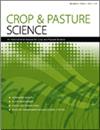Genotypic variability and physio-morphological efficiency of buckwheat (Fagopyrum spp.) under moisture stress at mid-altitudes of Meghalaya (India)
IF 1.9
4区 农林科学
Q2 AGRICULTURE, MULTIDISCIPLINARY
引用次数: 2
Abstract
Abstract Context. Crop production in Eastern Himalaya is constrained by combined effects of soil acidity and moisture deficit during post monsoon under a changing climate. Aim. This study aimed to identify potential buckwheat genotypes and stress mechanisms in hill environments of Meghalaya (India). Method. Field and microcosm experiments were conducted to study field performance, genotypic variability and physio-morphological efficiency in buckwheat. Key results. Substantial genetic variability for shoot length (30.3–110 cm), crop canopy distribution (3.0–7.5 number of primary branches), leaf area retention (15.7–60.2 cm2/two leaves), 1000 seed weight (16.2–34.7 g) and seed yield (0.088–1.31 metric tonne (MT)/ha) was observed. Mean grain yield of buckwheat genotypes was 0.446 MT/ha whereas IC13411, IC24298 and IC37305 produced significantly higher seed yield (1.31, 1.28 and 1.14 MT/ha, respectively) accounting to 1.93, 1.87 and 1.67 times higher than average yield (0.680 MT/ha). Genotypes like IC42416, EC323730 and EC218784 have lower crop yields (0.8, 1.02, 0.93 MT/ha respectively). Interestingly, few high yielders (IC13411 and IC24298) exhibited higher photosynthetic rate (46.1 and 32.3 μmol/m2.s), increased stomatal conductance (311.0 and 326.2 mmol/m2.s), leaf chlorophyll (2.47 and 2.55 mg/g fresh weight (FW)) and carotenoids (95 and 106.3 μg/g FW). Chlorophyll a and b ratio (3.3 and 3.0) and total chlorophyll to carotenoids (4.2 and 4.0) were higher in high yielders (IC13411 and IC24298) compared to other low yielders. Conclusions. Robust root systems, stomatal structure and higher cuticle wax ideally enhanced water use efficiency (WUE) and drought tolerance in high-yielding buckwheat genotypes. Implications. IC13411 and IC24298 are promising for enhanced productivity in the mountainous ecosystem of Meghalaya.梅加拉亚(印度)中海拔地区水分胁迫下荞麦(Fagopyrum spp.)的基因型变异和生理形态效率
抽象上下文。喜马拉雅东部的作物生产受到气候变化下后季风期间土壤酸度和水分不足的综合影响。目标本研究旨在确定梅加拉亚(印度)丘陵环境中荞麦的潜在基因型和胁迫机制。方法通过田间和微观试验研究了荞麦的田间表现、基因型变异和生理形态效率。关键成果。在芽长(30.3–110 cm)、作物冠层分布(3.0–7.5个主枝)、叶面积保持率(15.7–60.2 cm2/两片叶子)、1000粒种子重量(16.2–34.7 g)和种子产量(0.088–1.31公吨/公顷)方面观察到了显著的遗传变异。荞麦基因型的平均粮食产量为0.446 MT/公顷,而IC13411、IC24298和IC37305的种子产量显著较高(分别为1.31、1.28和1.14 MT/公顷),分别是平均产量(0.680 MT/公顷)的1.93、1.87和1.67倍。IC42416、EC323730和EC218784等基因型的作物产量较低(分别为0.8、1.02和0.93公吨/公顷)。有趣的是,很少有高产菌株(IC13411和IC24298)表现出更高的光合速率(46.1和32.3μmol/m2.s)、增加的气孔导度(311.0和326.2 mmol/m2.s)、叶片叶绿素(2.47和2.55 mg/g鲜重(FW))和类胡萝卜素(95和106.3μg/g FW)。与其他低产量作物相比,高产量作物(IC13411和IC24298)的叶绿素a和b比率(3.3和3.0)以及总叶绿素与类胡萝卜素的比率(4.2和4.0)更高。结论。结实的根系、气孔结构和较高的角质层蜡质理想地提高了高产荞麦基因型的水分利用效率和抗旱性。含义。IC13411和IC24298有望提高梅加拉亚山区生态系统的生产力。
本文章由计算机程序翻译,如有差异,请以英文原文为准。
求助全文
约1分钟内获得全文
求助全文
来源期刊

Crop & Pasture Science
AGRICULTURE, MULTIDISCIPLINARY-
CiteScore
4.20
自引率
15.80%
发文量
111
审稿时长
3 months
期刊介绍:
Crop and Pasture Science (formerly known as Australian Journal of Agricultural Research) is an international journal publishing outcomes of strategic research in crop and pasture sciences and the sustainability of farming systems. The primary focus is broad-scale cereals, grain legumes, oilseeds and pastures. Articles are encouraged that advance understanding in plant-based agricultural systems through the use of well-defined and original aims designed to test a hypothesis, innovative and rigorous experimental design, and strong interpretation. The journal embraces experimental approaches from molecular level to whole systems, and the research must present novel findings and progress the science of agriculture.
Crop and Pasture Science is read by agricultural scientists and plant biologists, industry, administrators, policy-makers, and others with an interest in the challenges and opportunities facing world agricultural production.
Crop and Pasture Science is published with the endorsement of the Commonwealth Scientific and Industrial Research Organisation (CSIRO) and the Australian Academy of Science.
 求助内容:
求助内容: 应助结果提醒方式:
应助结果提醒方式:


